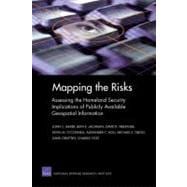
| Preface | iii | ||||
| Sponsor Guidance | v | ||||
| The RAND Corporation Quality Assurance Process | vii | ||||
| Figures | xiii | ||||
| Tables | xv | ||||
| Summary | xvii | ||||
| Acknowledgments | xxxv | ||||
| Abbreviations | xxxvii | ||||
| CHAPTER ONE Introduction | 1 | (16) | |||
|
3 | (3) | |||
|
6 | (2) | |||
|
8 | (2) | |||
|
10 | (2) | |||
|
10 | (1) | |||
|
11 | (1) | |||
|
12 | (2) | |||
|
14 | (3) | |||
| CHAPTER TWO What Are the Attackers' Key Information Needs? | 17 | (24) | |||
|
18 | (1) | |||
|
19 | (2) | |||
|
21 | (1) | |||
|
22 | (2) | |||
|
24 | (14) | |||
|
27 | (2) | |||
|
29 | (5) | |||
|
34 | (3) | |||
|
37 | (1) | |||
|
38 | (1) | |||
|
39 | (2) | |||
| CHAPTER THREE What Publicly Available Geospatial Information Is Significant to Potential Attackers' Needs? | 41 | (52) | |||
|
42 | (6) | |||
|
42 | (6) | |||
|
48 | (11) | |||
|
50 | (6) | |||
|
56 | (3) | |||
|
59 | (4) | |||
|
63 | (10) | |||
|
64 | (2) | |||
|
66 | (3) | |||
|
69 | (2) | |||
|
71 | (2) | |||
|
73 | (14) | |||
|
75 | (8) | |||
|
83 | (4) | |||
|
87 | (2) | |||
|
87 | (2) | |||
|
89 | (4) | |||
| CHAPTER FOUR An Analytical Framework for Assessing the Homeland Security Implications of Publicly Accessible Geospatial Information | 93 | (28) | |||
|
94 | (1) | |||
|
95 | (10) | |||
|
96 | (2) | |||
|
98 | (1) | |||
|
99 | (4) | |||
|
103 | (2) | |||
|
105 | (7) | |||
|
110 | (2) | |||
|
112 | (2) | |||
|
112 | (2) | |||
|
114 | (5) | |||
|
119 | (2) | |||
| CHAPTER FIVE Key Findings and Recommendations | 121 | (10) | |||
|
121 | (3) | |||
|
121 | (2) | |||
|
123 | (1) | |||
|
124 | (3) | |||
|
127 | (1) | |||
|
128 | (3) | |||
| APPENDIX | |||||
|
131 | (4) | |||
|
135 | (36) | |||
|
171 | (8) | |||
|
179 | (12) | |||
| Bibliography | 191 |
The New copy of this book will include any supplemental materials advertised. Please check the title of the book to determine if it should include any access cards, study guides, lab manuals, CDs, etc.
The Used, Rental and eBook copies of this book are not guaranteed to include any supplemental materials. Typically, only the book itself is included. This is true even if the title states it includes any access cards, study guides, lab manuals, CDs, etc.